Note: Insect trap data are unavailable from much of southern New Jersey this past week due to staff shortages. No maps will appear in this edition. Maps will resume later in September as conditions permit. Interpretations from available data will continue in the absence of maps.
Sweet Corn
European corn borer (ECB) moth catches are nearly non-existent now. At this time, no feeding has been detected.
Corn earworm (CEW) moth captures from blacklight traps and pheromone traps have declined with cooler evening temperatures. Pheromone traps in Burlington County and northern Warren County continue to be higher than most, although all have registered lower catches. Both trap types are in general agreement as to spray schedules. CEW populations can increase or decline with changes in night temperatures. Growers should continue to be on alert for large CEW migrations should NJ experience significant weather events such as tropical storms. Check this publication weekly for CEW status.
The highest available nightly blacklight trap catches of CEW for the week ending 09/14/22 are as follows:
| Georgetown 13 | New Egypt 6 | Farmingdale 5 |
| Clinton 8 | Pennington 6 | Lawrenceville 4 |
| Crosswicks 8 | Dayton 5 | Old Bridge 3 |
| Allentown 6 | Denville 5 |
Princeton3
The highest available nightly pheromone trap catches of CEW for the week ending 09/14/22 are as follows:
| Allamuchy 70 | Califon 17 | Matawan 6 |
| Georgetown 42 | Farmingdale 12 | Chester 4 |
| Snyder Farm (Hunterdon) 31 | Dayton 10 | |
| Jones Island 18 | South Branch 7 |
Silking Spray Schedules*:
South – 3 days
Central – 3 days
North – 3 days
*These recommendations are based on regional catches. Adhere to tighter spray schedules if indicated by local trap catches. Synthetic pyrethroids alone should NOT be used for corn earworm (CEW) protection on silking corn, or for fall armyworm (FAW) management at any stage. Control with these materials is very inconsistent. Utilize materials in IRAC groups 5 and 28, or combination products that include IRAC group 28 for best control. See the Sweet Corn section of the 2022-23 Commercial Vegetable Production Guide for selections.
Two-spotted spider mites (TSSM) continue to infest sweet corn plantings as they approach the silk stage, although recent heavy rains should ease this situation somewhat. Insecticide applications for CEW control often intensify these infestations. Check plantings prior to the onset of silks. Mite populations in corn will result in lower leaves first appearing “dusty”, and ultimately turning yellow. This condition progresses up the plant as mite populations increase. If mites are detected in any plantings, the addition of the miticide Oberon (5-day PHI) to the normal silk spray schedule can help minimize injury. Zeal is also labeled in corn but must be used early in the silk schedule as it carries a 21 day PHI.
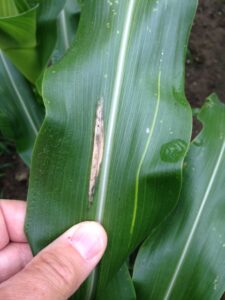 Northern corn leaf blight (NCLB) is now appearing in some northern county plantings. This foliar disease can reduce ear size if lesions (see photo at right) expand to consume enough leaf surface early in the life of the plant. Later infections may be inconsequential, or possibly result in lesions on the husks, making them less appealing. Cooler nights and longer dew periods favor this disease. Plantings that haven’t yet begun to silk when lesions appear may require fungicide applications to limit injury. See the Sweet Corn section of the 2022-23 Commercial Vegetable Production Guide for appropriate materials.
Northern corn leaf blight (NCLB) is now appearing in some northern county plantings. This foliar disease can reduce ear size if lesions (see photo at right) expand to consume enough leaf surface early in the life of the plant. Later infections may be inconsequential, or possibly result in lesions on the husks, making them less appealing. Cooler nights and longer dew periods favor this disease. Plantings that haven’t yet begun to silk when lesions appear may require fungicide applications to limit injury. See the Sweet Corn section of the 2022-23 Commercial Vegetable Production Guide for appropriate materials.
Tomatoes
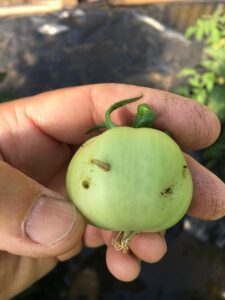 Consideration should be given to protecting tomato plantings from CEW in tomatoes (called the fruitworm, when found in tomatoes). Larger populations locally, (>20 CEW/night) in local pheromone traps are a signal that growers should be inspecting tomato plantings at least weekly for signs of fruit injury. Typically, the female CEW moth lays eggs in blossom clusters near the outer canopy of the plant. Larvae hatching from these eggs begin feeding on the nearest fruit (photo at left), making damage very visible while walking the planting. At the first sign of this injury, growers should initiate control, with insecticides in the IRAC 5 and 28 classes most effective, with short PHIs. There are a number of effective insecticides listed in the Tomato Section from the 2022-23 Guide.
Consideration should be given to protecting tomato plantings from CEW in tomatoes (called the fruitworm, when found in tomatoes). Larger populations locally, (>20 CEW/night) in local pheromone traps are a signal that growers should be inspecting tomato plantings at least weekly for signs of fruit injury. Typically, the female CEW moth lays eggs in blossom clusters near the outer canopy of the plant. Larvae hatching from these eggs begin feeding on the nearest fruit (photo at left), making damage very visible while walking the planting. At the first sign of this injury, growers should initiate control, with insecticides in the IRAC 5 and 28 classes most effective, with short PHIs. There are a number of effective insecticides listed in the Tomato Section from the 2022-23 Guide.
Peppers
Reaching mid-September lowers the concern of significant damage from the weevil. Cooler temperatures will slow its life cycle to 3 1/2 weeks or longer. Depending upon the price of peppers, most pepper farmers will soon stop harvesting. Weevils will only be a problem for those trying to extend their season.
That said, pepper weevils are remarkably cold tolerant and survive light frosts, and will continue to be active until their solanaceous host plants are dead. They lack the ability to diapause, so they will not survive the winter here without food.
The best control rotations for pepper weevil include Vydate, a neonicotinoid (Actara, Admire, Assail, others), a diamide (Exirel, Harvanta), and possibly Torac. University of Georgia researchers have found that all populations of pepper weevil that they have tested are resistant to pyrethroids. Since we don’t know where the weevils come from that we find here in New Jersey, farmers probably shouldn’t rely on pyrethroids being effective. Refer to the Rutgers Fact Sheet, FS1330: Monitoring and Management of Pepper Weevil in New Jersey (Rutgers NJAES) for more details on monitoring pepper weevil populations.
Beet armyworm adults (BAW) continue to be captured over the past week. Nightly counts include:
| Jones Island 17 |
Growers in Gloucester, Salem and Cumberland counties should monitor pepper fields weekly for signs of feeding. BAW larvae (photo at left) feed in the developing foliage in terminal growth of plants. Initially, leaves are skeletonized, but as larvae grow, they will move onto fruit and damage these as well. 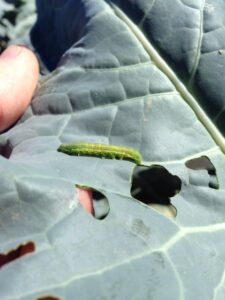 As with other armyworms, BAW is difficult to control with pyrethroid insecticides. Effective materials include spinosyns (IRAC 5) and diamides (IRAC 28).
As with other armyworms, BAW is difficult to control with pyrethroid insecticides. Effective materials include spinosyns (IRAC 5) and diamides (IRAC 28).
Pumpkins and Winter Squash
Cucurbit downy mildew (CDM) is active on cucumbers in all parts of the state, and has recently been discovered on summer squash in southern NJ (See Dr. Wyenandt’s alert of 9/5). As of 9/13, no infections have been detected on other cucurbits in NJ, including pumpkins, butternut squash, acorn squash and watermelons. As of Tuesday 9/13, the CDM forecast was for high risk of new infection in all of NJ. Rains of 9/12 and continued cloudy weather on 9/13 were conducive to local spread. For regional information on this important disease, see the Cucurbit Downy Mildew Forecast webpage: http://cdm.ipmpipe.org/. It is advisable that all growers treat preventively for CDM on all vine crops until clear, dry weather resumes and infections either become evident or are determined not to have occurred.
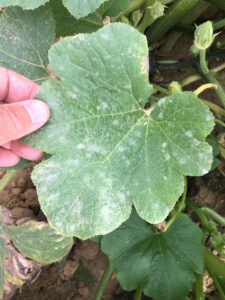 Powdery mildew (PM) infections are present in all scouted pumpkin and winter squash fields, and protectant spray programs for this fungal disease are ongoing. Growers should include protectant and systemic fungicides for powdery mildew management. For a review of PM control, see Dr. Andy Wyenandt’s article on PM control from earlier this season.
Powdery mildew (PM) infections are present in all scouted pumpkin and winter squash fields, and protectant spray programs for this fungal disease are ongoing. Growers should include protectant and systemic fungicides for powdery mildew management. For a review of PM control, see Dr. Andy Wyenandt’s article on PM control from earlier this season.
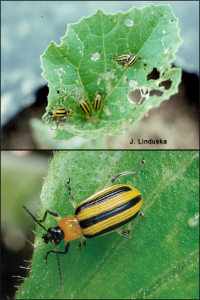 As fruit develop and mature in fields, growers should check at least weekly for the presence of striped cucumber beetles (photo at right). This pest, which is important early in the life of the plants, again becomes economically significant with maturing fruit, as it can scar the rinds of pumpkins and other squashes. If cucumber beetles are found at more than 2 sites in a 10 site sample, and any fruit injury is detected, an insecticide application to prevent further injury may be warranted. For useful materials, see the Pumpkin and Winter Squash section of the 2022-23 Commercial Guide.
As fruit develop and mature in fields, growers should check at least weekly for the presence of striped cucumber beetles (photo at right). This pest, which is important early in the life of the plants, again becomes economically significant with maturing fruit, as it can scar the rinds of pumpkins and other squashes. If cucumber beetles are found at more than 2 sites in a 10 site sample, and any fruit injury is detected, an insecticide application to prevent further injury may be warranted. For useful materials, see the Pumpkin and Winter Squash section of the 2022-23 Commercial Guide.
As of last week, populations of melon aphids have begun to appear in pumpkin and winter squash fields (see photo below at left). This pest has the ability to increase to extremely high population levels in fields. When this happens, their sticky droppings are deposited on fruit below the canopy. Sooty 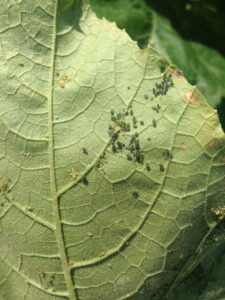 mold fungus grows on this sticky coating, disfiguring fruit. Additionally, hornets are attracted to the aphid droppings; creating a potential issue in U-pick situations. Check fields weekly for the presence of melon aphid colonies developing on the undersides of leaves. If aphids are found in more than one sample site/10 sites, consider an insecticide application to limit population spread. There are a number of effective materials listed in the Pumpkin and Winter Squash section of the 2022-23 Commercial Guide. Avoid pyrethroid insecticides for aphids or other insect pests, as these can cause aphids to increase.
mold fungus grows on this sticky coating, disfiguring fruit. Additionally, hornets are attracted to the aphid droppings; creating a potential issue in U-pick situations. Check fields weekly for the presence of melon aphid colonies developing on the undersides of leaves. If aphids are found in more than one sample site/10 sites, consider an insecticide application to limit population spread. There are a number of effective materials listed in the Pumpkin and Winter Squash section of the 2022-23 Commercial Guide. Avoid pyrethroid insecticides for aphids or other insect pests, as these can cause aphids to increase.
Cole Crops
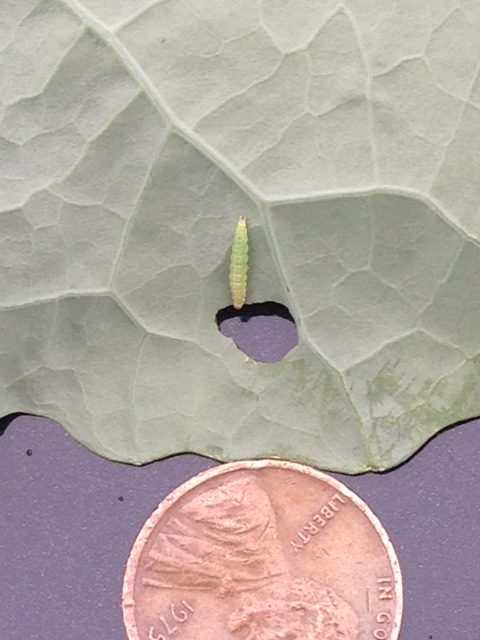 In any areas, diamondback moth larvae ((DBM) see photo at right) are the dominant caterpillar pest in cole crop plantings. This pest can multiply quickly, with a generation completed in under 2 weeks with high temperatures. Furthermore, this pest is not responding to chlorantraniliprole (Coragen) in many parts of the state. Effective materials continue to be IRAC 1A (Lannate), IRAC 5 materials (spinosyns), other IRAC 28 products like Exirel, and the IRAC 6 material, ememectin benzoate (Proclaim). Be sure to check the Cole Crops Section of the 2022-23 Commercial Guide for specifics, as PHI’s and crop labels vary. It is important to return to treated fields within 2-3 days to assess the efficacy of the insecticide applications. Effective materials should eliminate DBM larvae within 48 hours.
In any areas, diamondback moth larvae ((DBM) see photo at right) are the dominant caterpillar pest in cole crop plantings. This pest can multiply quickly, with a generation completed in under 2 weeks with high temperatures. Furthermore, this pest is not responding to chlorantraniliprole (Coragen) in many parts of the state. Effective materials continue to be IRAC 1A (Lannate), IRAC 5 materials (spinosyns), other IRAC 28 products like Exirel, and the IRAC 6 material, ememectin benzoate (Proclaim). Be sure to check the Cole Crops Section of the 2022-23 Commercial Guide for specifics, as PHI’s and crop labels vary. It is important to return to treated fields within 2-3 days to assess the efficacy of the insecticide applications. Effective materials should eliminate DBM larvae within 48 hours.

